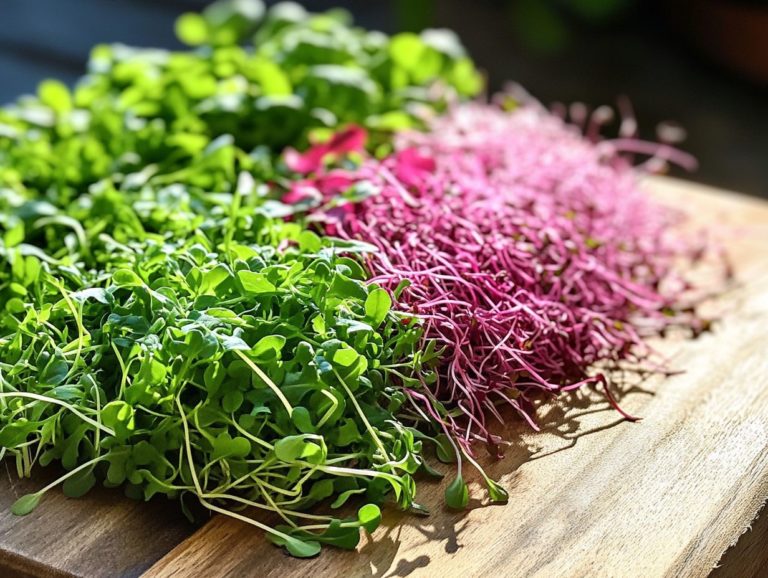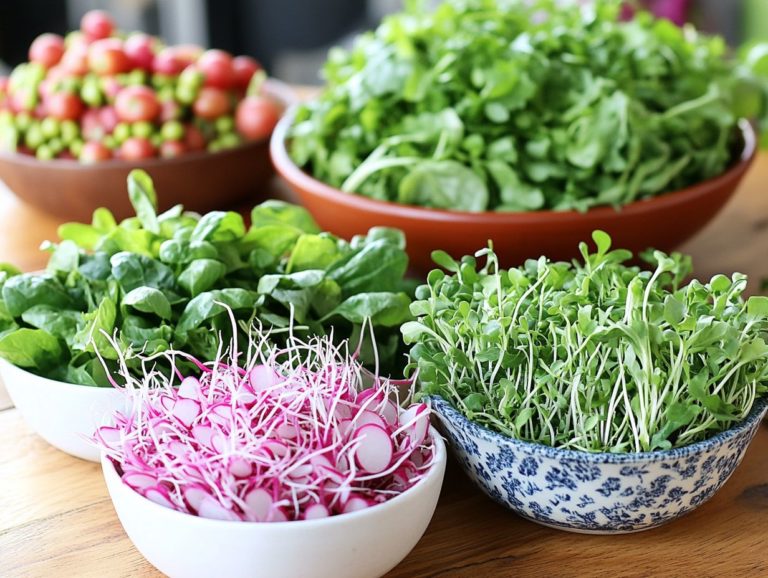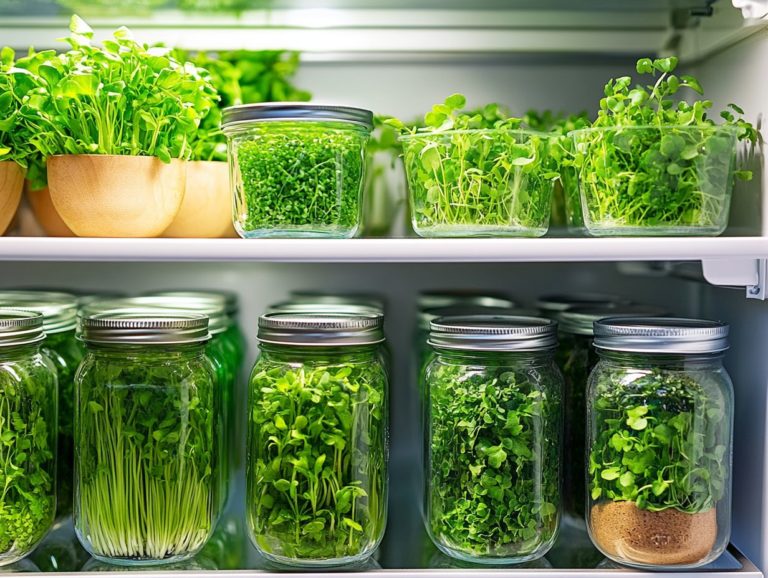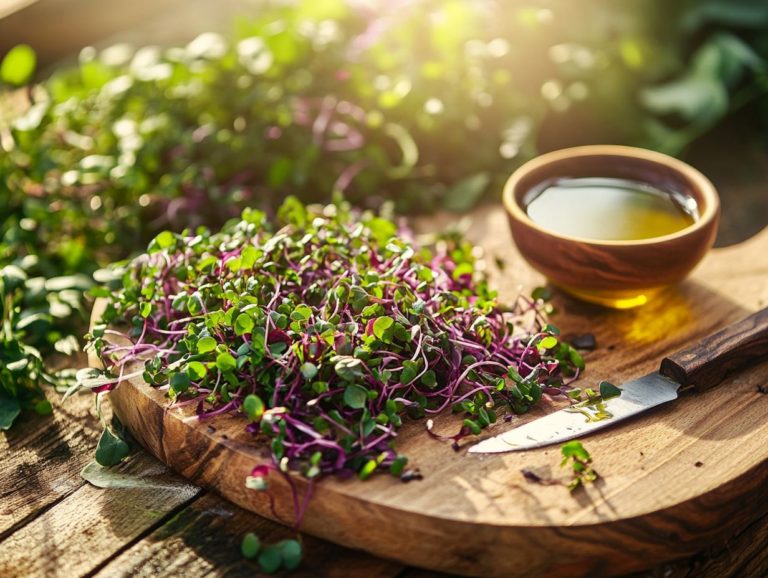Exploring the Benefits of Edible Microgreens
Edible microgreens are far more than just a trendy garnish; they are a concentrated powerhouse of nutrients encapsulated in tiny leaves!
In this article, you will delve into what microgreens are. You ll explore how they stack up nutritionally against their mature counterparts and uncover the impressive health benefits they bring. These include enhanced nutrient absorption and robust antioxidant properties.
You ll also find a step-by-step guide to growing your own microgreens, along with creative ways to incorporate them into your meals. Important food safety considerations will be addressed too.
Get ready to discover why these miniature greens truly deserve a prominent place on your plate!
Contents
Key Takeaways:
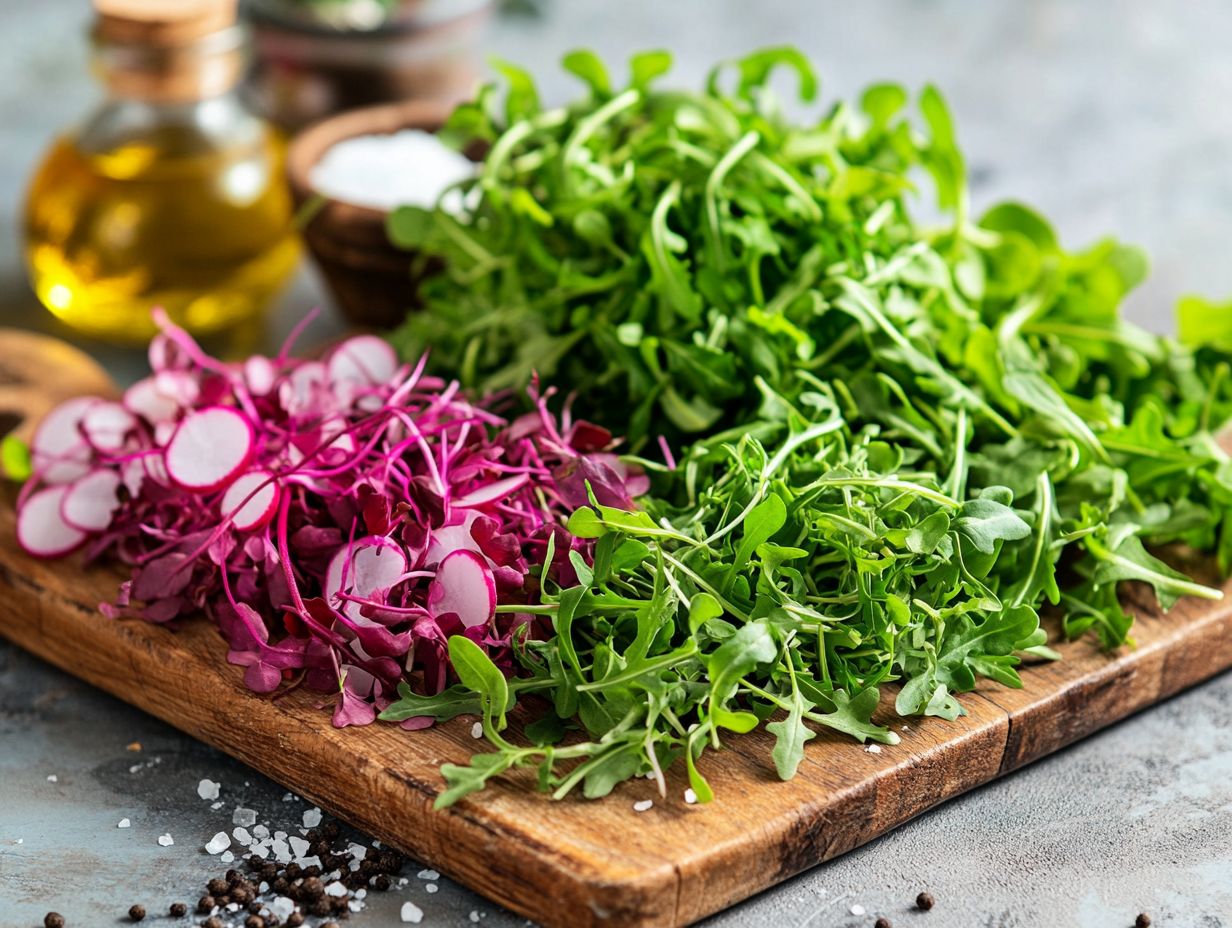
- Edible microgreens are young, tender plants that are harvested after the first few weeks of growth.
- Despite their small size, microgreens pack a powerful nutritional punch, containing higher levels of vitamins, minerals, and antioxidants compared to mature plants.
- Incorporating microgreens into your diet can lead to improved nutrient absorption and provide anti-inflammatory and antioxidant benefits for overall health and well-being.
What are Edible Microgreens?
Microgreens are young vegetables harvested just after the first true leaves emerge. They burst with flavor and vibrant colors that elevate any healthy diet. These petite, edible plants aren t just a feast for the eyes; they also bring a culinary delight to your table, enhancing dishes with their robust taste and visual appeal.
As members of the vegetable family, they encompass a variety of species, including broccoli, amaranth, and spinach. Beyond their culinary charm, microgreens boast impressive nutritional benefits, making them a favored choice for those who prioritize health and wellness.
Definition and Characteristics
Microgreens are essentially young vegetables and edible plants that you harvest just after the first true leaves emerge. They’re celebrated for their concentrated nutrients and vibrant flavors.
These little culinary marvels can be grown from a variety of species, such as radishes, mustard greens, and basil. Each brings its own unique taste and visual appeal to your dishes. The growth stages of microgreens are impressively swift, typically taking just 7 to 21 days from sowing to harvest, making them an excellent choice for both home gardeners and chefs.
With their remarkable nutrients packed into them, these greens can often rival their mature counterparts in vitamins and minerals, offering significant health benefits. For instance, broccoli microgreens are particularly famous for their high levels of sulforaphane, a compound found in vegetables that may help prevent cancer. Meanwhile, sunflower microgreens are packed with healthy fats and antioxidants, making them a fantastic option for a nutritious garnish. Additionally, exploring the benefits of indoor microgreen growing can further enhance your gardening experience.
Nutritional Value of Microgreens
The nutritional value of microgreens is truly remarkable. These tiny powerhouses are often packed with vitamins and minerals, delivering concentrated nutrients that can offer substantial health benefits, all in a petite package.
Comparison to Mature Plants
When you compare microgreens to their mature plant counterparts, it becomes clear that microgreens are a nutritional powerhouse, packed with a significantly higher concentration of vitamins, minerals, and antioxidants.
These young plants are rich in iron. They also contain phytochemicals that promote health. For example, many microgreens can contain up to five times more vitamin C than their fully grown relatives, enhancing their antioxidant properties. This impressive nutritional profile not only supports your immune function but also offers anti-inflammatory benefits.
The concentrated amounts of essential fatty acids and micronutrients found in microgreens help foster better nutrient absorption and overall vitality. By incorporating these vibrant greens into your diet, you can experience improved health outcomes, making them an excellent choice for anyone aiming to elevate their nutrition naturally.
Start adding these powerful greens to your plate today for a health boost!
Health Benefits of Edible Microgreens
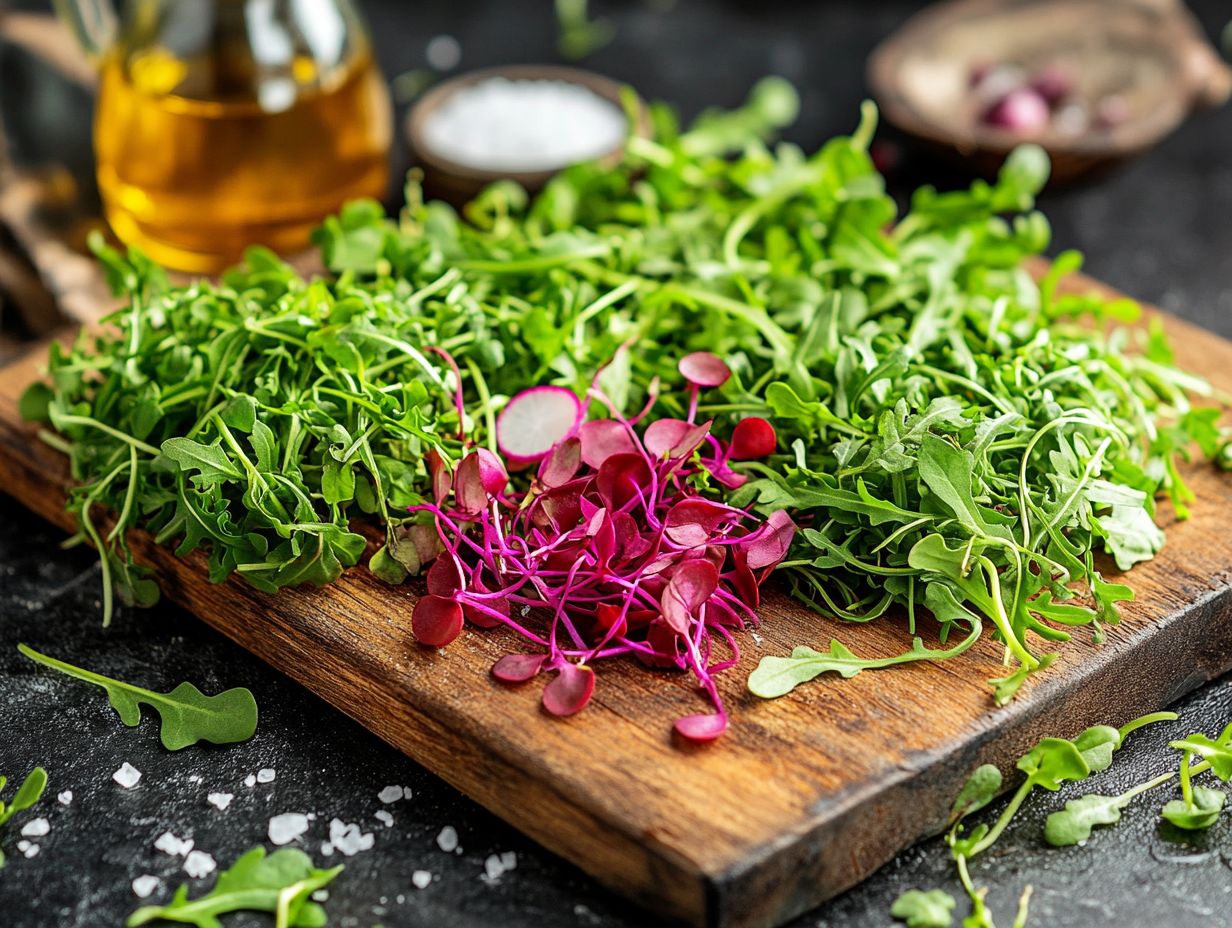
The health benefits of edible microgreens are impressive. They can help lower cholesterol, enhance heart health, and play a role in reducing insulin resistance.
Some studies suggest they may also have properties that could aid in cancer prevention.
Improved Nutrient Absorption
One of the most impressive health benefits of microgreens is their ability to enhance nutrient absorption.
Research shows that the rich density of vitamins, minerals, and antioxidants found in microgreens like broccoli and radish can boost your body’s capacity to absorb essential nutrients.
For example, enjoying these tiny greens can increase how well your body uses nutrients, especially when paired with healthy fats. Pairing microgreens with healthy fats helps your body absorb those important vitamins!
Nutritionists encourage adding microgreens to your meals, not just for the delightful burst of flavor they bring, but also for their potential to elevate the nutritional profile of everyday foods. They make a fantastic addition to a balanced diet.
Antioxidant and Anti-inflammatory Properties
Microgreens are a treasure trove of antioxidants and phytochemicals, which contribute to their impressive antioxidant and anti-inflammatory properties.
These tiny greens combat oxidative stress a condition linked to various chronic diseases. By neutralizing harmful free radicals, microgreens help reduce inflammation, supporting cardiovascular health and enhancing your immune function.
Research suggests that incorporating these plants into your balanced diet bolsters your overall wellness and may improve your skin health and promote optimal digestion.
As you seek natural ways to elevate your well-being, microgreens present a delicious and powerful solution, packed with essential vitamins and minerals.
How to Grow and Use Edible Microgreens
Growing and utilizing edible microgreens is a straightforward yet fulfilling endeavor. It can significantly enhance your diet and bolster food security, making them perfect for urban gardeners and health aficionados.
This step-by-step guide to growing microgreens will walk you through the entire process, from seed selection to harvesting.
Microgreens, like broccoli or fenugreek, are bursting with flavor and packed with vitamins and minerals essential for a healthy diet.
To kick things off, selecting high-quality seeds is paramount, as this choice impacts both the yield and the taste of your microgreens.
Once you ve chosen your seeds, prepare a shallow container with an effective drainage system. Fill it with a nutrient-rich soil mix, keeping it moist but not overly wet.
After sowing the seeds, lightly cover them with soil to encourage germination. Regular watering and providing adequate light will nurture their growth, leading to a bountiful harvest brimming with flavor and nutrients.
Why wait? Start your own microgreens garden today and enjoy the health benefits right at home!
Creative Ways to Incorporate Microgreens into Your Diet
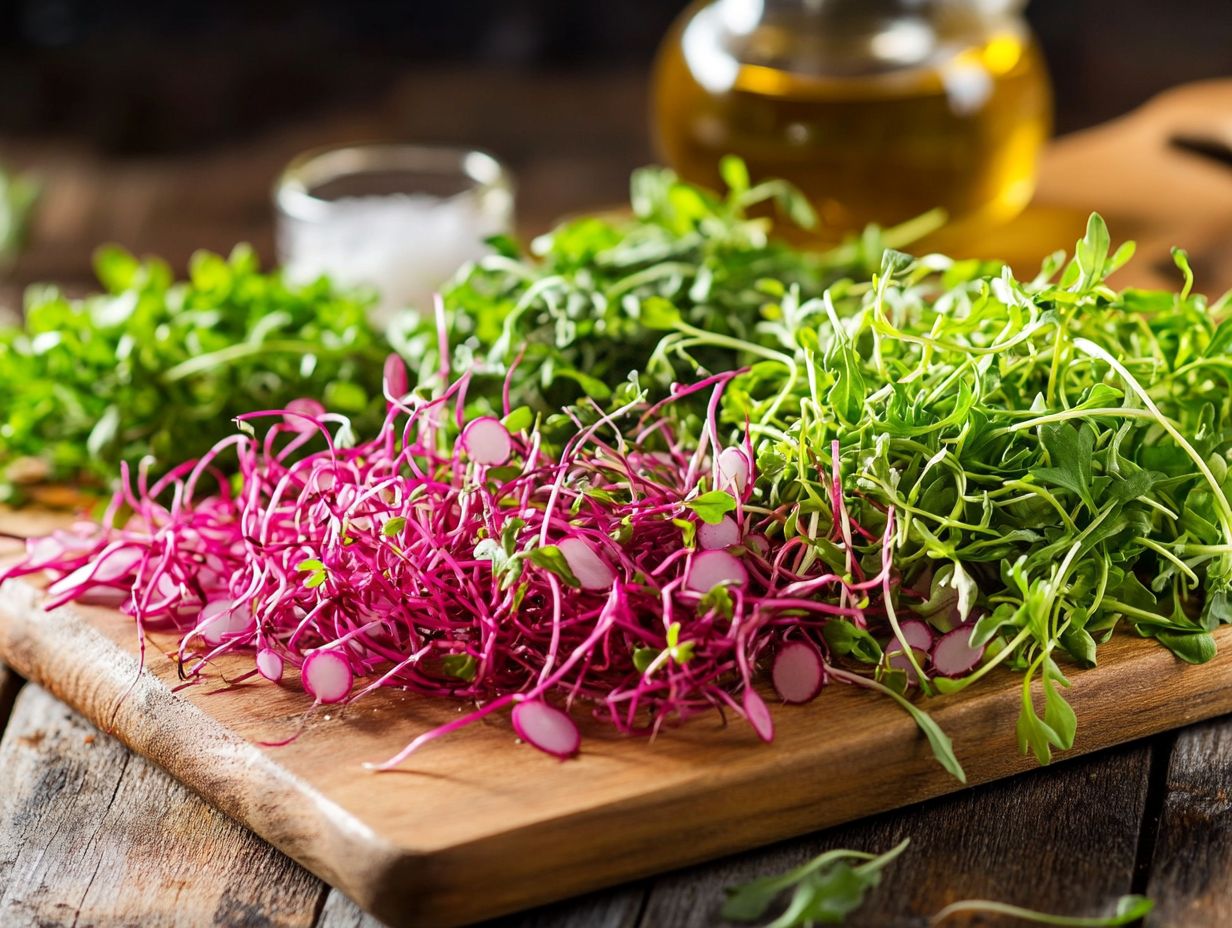
Incorporating microgreens into your diet can be a delightful and imaginative journey, offering you countless ways to elevate your meals while promoting food security and a healthy lifestyle.
These small but powerful greens can enhance a variety of dishes imagine vibrant salads where peppery arugula microgreens elevate the flavor profile to new heights or layered into sandwiches, delivering a refreshing crunch that perfectly complements creamy spreads.
If smoothies are more your style, toss in a handful of nutrient-rich kale microgreens to seamlessly boost both taste and health benefits without overpowering the original flavor.
By experimenting with these lively greens, you ll embark on exciting culinary adventures. Transform each meal into a feast that is not only visually stunning but also brimming with essential vitamins and minerals.
Potential Risks and Precautions
While microgreens provide impressive health benefits, stay alert to potential risks and food safety concerns linked to their cultivation and consumption.
Food Safety Concerns
Food safety should be at the forefront of your mind when growing and consuming microgreens. Understanding these health risks is essential for ensuring a safe and enjoyable experience.
While microgreens are celebrated for their rich nutrients and vibrant flavors, they can contain harmful bacteria like E. coli and Salmonella, which can cause food poisoning. To minimize these risks, experts recommend rinsing microgreens thoroughly under running water to eliminate contaminants and using clean utensils and surfaces during preparation. Additionally, exploring ways to enhance flavor in microgreens can further elevate your culinary experience.
It’s also wise to source these young plants from reputable suppliers who uphold hygiene standards. Experience the amazing freshness of microgreens without compromising your health.
Frequently Asked Questions
What are microgreens?
Microgreens are young vegetable greens that are harvested after sprouting but before they reach full maturity. These tiny plants are typically grown from the seeds of vegetables, herbs, or grains and are packed with nutrients.
What are the benefits of consuming microgreens?
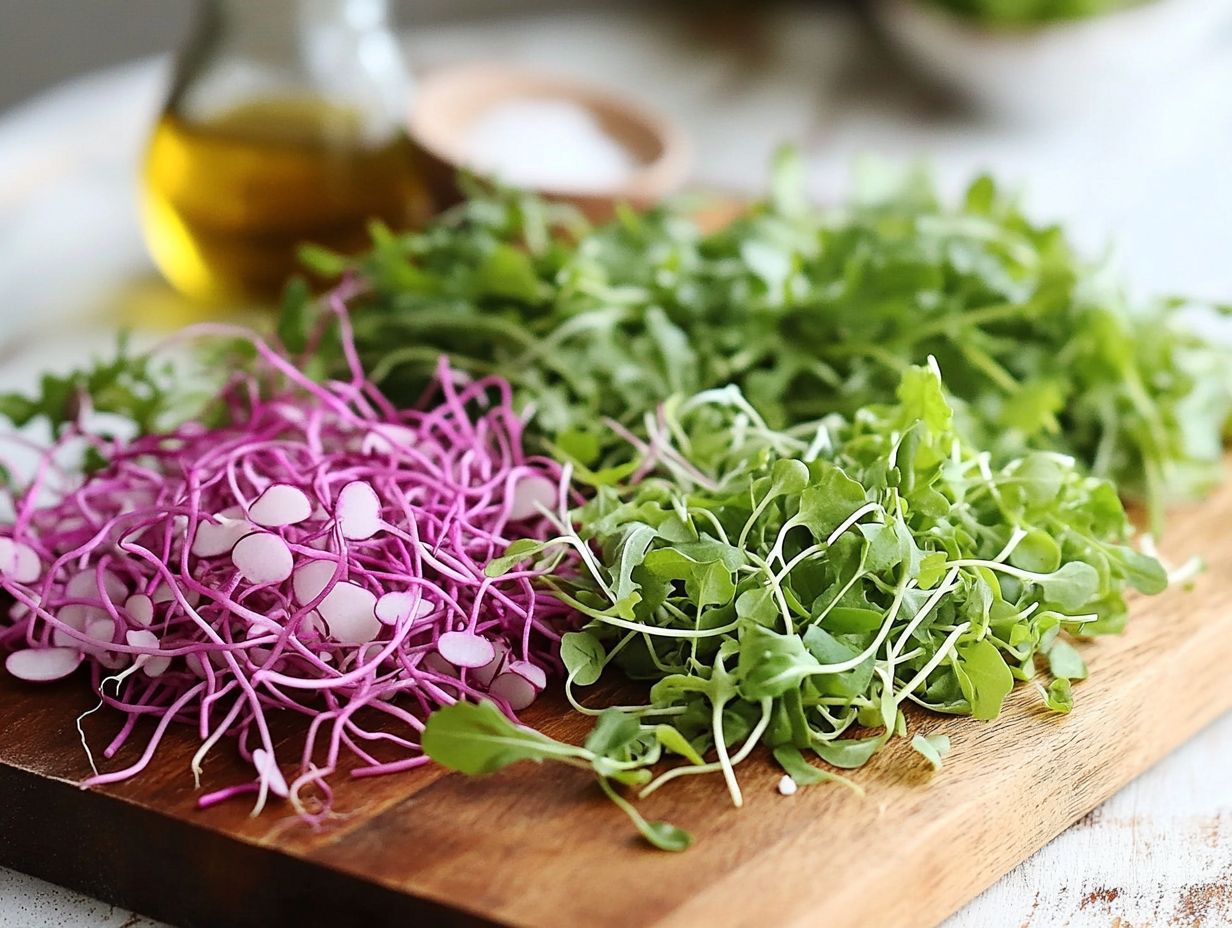
There are numerous benefits to consuming microgreens. They are packed with nutrients, including vitamins, minerals, and antioxidants. They can also help improve digestion, boost the immune system, and regulate blood sugar levels.
Do microgreens have a specific taste?
Yes, microgreens have a distinct taste that varies depending on the type of plant. Some are mild and slightly sweet, while others are more peppery or bitter. This makes them a versatile addition to any dish.
How can I incorporate microgreens into my diet?
Microgreens can be easily incorporated into your diet by adding them to salads, sandwiches, wraps, smoothies, or even as a garnish on top of soups or main dishes. They add a burst of flavor and nutrition to any meal.
Are there any specific health benefits of edible microgreens?
Yes, edible microgreens have numerous health benefits. They are an excellent source of vitamins, including vitamins C, E, and K, as well as minerals such as iron, potassium, and calcium. They also contain high levels of antioxidants, which can help protect against chronic diseases.
Can anyone grow microgreens at home?
Yes, anyone can grow microgreens at home with minimal space and equipment. They can be grown in small containers on a windowsill or in a small garden. They require little maintenance and can be harvested in just a few weeks.
Start adding microgreens to your meals today for a flavorful boost!

